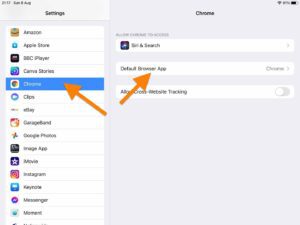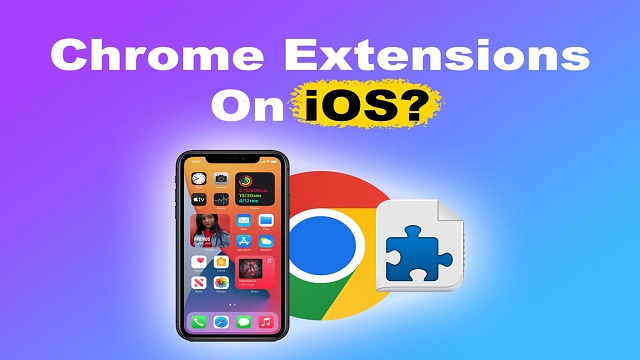How Do I Enable Chrome on iOS?
Enable Chrome On iOS brings all the features you love from Chrome to your iPhone. Features like Sync, Google Translate, Incognito and Autofill.
With iOS 14, some apps that have link actions can set Chrome as their default browser so that links will open in Chrome instead of Safari. However, this is not available for all apps. Some apps are required to use Apple’s WebKit engine and therefore cannot support Chrome extensions.
Enabling Chrome on iOS is a straightforward process. Google Chrome is a popular web browser known for its speed, simplicity, and synchronization capabilities across devices. Follow these steps to enable Chrome on your iOS device.

Follow These Steps:
- Download Chrome from the App Store: Open the App Store on your iOS device and search for “Google Chrome.” Tap on the Chrome app in the search results, and then tap the “Get” button to download and install the app. If prompted, enter your Apple ID password or use Touch ID/Face ID to authenticate the download.
- Open Chrome: Once the installation is complete, locate the Chrome icon on your home screen and tap to open the browser.
- Sign in with your Google Account: To sync your browsing history, bookmarks, and other data across devices, sign in with your Google Account. Tap the three dots in the bottom-right corner of the screen to open the menu, and then select “Sign in to Chrome.” Enter your Google email address and password, and follow any additional prompts to complete the sign-in process.
Follow These Steps:
- Set Chrome as the Default Browser (Optional): While you can’t set Chrome as the default browser system-wide on iOS, you can make it behave more like the default. Open the “Settings” app on your iOS device, scroll down and tap on “Chrome,” then tap on “Default Browser App” and select “Chrome” from the list.
- Enable or Disable Notifications (Optional): Chrome can send you notifications for various events, such as new emails or updates from websites. To enable or disable notifications, go to your device’s “Settings,” scroll down to “Chrome,” and then tap on “Notifications.” Toggle the switch to enable or disable notifications according to your preference.
- Customize Chrome Settings: Chrome offers a range of settings that allow you to customize your browsing experience. Tap the three dots in the bottom-right corner of the screen, then select “Settings.” Here, you can adjust various options, including privacy settings, site settings, and accessibility features. Explore these settings to tailor Chrome to your preferences.
- Enable Dark Mode (Optional): If you prefer a darker interface, Chrome on iOS supports Dark Mode. To enable it, go to Chrome’s settings, tap on “Theme,” and choose “Dark” from the options.
Follow These Steps:
- Manage Tabs and Windows: Chrome on iOS allows you to manage tabs easily. To open a new tab, tap the square icon in the bottom-right corner. To view all open tabs, swipe down from the top of the screen or tap the number icon next to the address bar. You can also open a new incognito tab for private browsing by tapping the incognito icon.
- Update Chrome (Optional): Ensure that you are using the latest version of Chrome to benefit from security updates and new features. Open the App Store, go to the “Updates” tab, and check if there is an update available for Chrome. If yes, tap “Update” next to the Chrome app.
- Explore Additional Features: Chrome on iOS comes with various features such as voice search, gesture navigation, and the ability to save articles for offline reading. Spend some time exploring these features to make the most of your browsing experience.
In conclusion, enabling Chrome on iOS involves downloading the app from the App Store, signing in with your Google Account, and customizing the settings to suit your preferences. With its user-friendly interface and synchronization capabilities, Chrome provides a seamless browsing experience on iOS devices.
How to Set Chrome as Your Default Browser
Chrome is one of the most popular browsers on the market, and it offers a ton of features that make it an ideal web browser for iOS. It also has integrations with native iOS apps like Gmail, Drive, and Telegram. As a result, any links you click in these apps will open in Chrome by default.
Thankfully, Apple has made it possible to set a third-party app as your default browser in iOS 14 and higher. This means that you can choose to have Chrome or another third-party browser as the default for all links in your apps, including those that you tap from SMS and email.
To do this, open your Settings app and scroll down to find the “Default Browser App” option. Once you see this option, select Chrome to set it as your default browser. You can also create a shortcut to the Google Chrome app on your home screen to quickly launch it.
How to Open Links in Chrome
For a long time, Apple’s iOS mobile operating system required that users manually pass over web links from other apps to Safari. That changed with the arrival of iOS 14 and iPadOS 14, when third-party browsers and email clients were enabled to become the default apps for web page links tapped in other apps.
With this Shortcuts workflow, you can tap a link inside any app to open it in Chrome. It’s a handy way to access websites from your phone that you normally wouldn’t have been able to with the native email and native browser apps on iOS.
Google has also introduced a number of other cool shortcuts in Chrome that can save you from the need to switch between apps. For example, if you want to look up an address on a map without switching to another app, just press and hold the detected address on a webpage, and Chrome will provide you with a mini Google Maps view of it.
How to Set Chrome as Your Default App
Chrome iOS is one of the fastest and most secure web browsers on the market. It is also available on iOS, macOS and Windows 10. By making Chrome your default app on your phone or tablet, you can easily access the same tabs across all devices. This means you can start a recipe on your computer and finish it on your phone or use Google Voice Search to find answers from anywhere.
To set Chrome as your default app, make sure you’re running a recent version of iOS (iOS 14 or later). Tap the Settings icon and select “Apps” to open the Default apps screen. Here, you can select a third-party browser as your default (Chrome, Firefox, Edge, Brave, etc).
In addition to making Chrome your default app, you can also add it to the home screen and drag it into the Dock. This will ensure that it is always easily accessible. You can also sync Chrome across all of your devices with a Google account, so you can share passwords and autofill information between them.
How to Disable Chrome’s Access to Mobile Data
Chrome uses a lot of your mobile data. It can preload content and share ungodly amounts of your personal information with Google, all in the name of “delivering you the most relevant ads.”
If you’re using an Apple device with iOS 14 or higher, you can choose to disable Chrome’s access to your mobile data on the Screen Time settings page. Tap the Utilities section, and then tap “App Limits.” Select an existing app limit that includes Chrome or add a new one.
This will prevent Chrome from accessing your mobile data while you use it, and will also help you develop a healthier relationship with technology. Use your digital landscape as a tool for productivity, not a bottomless pit of distractions and waste. This guide will teach you how to unlock your potential, reignite your passions, and reclaim your privacy. It’s time to master your tech! Start your journey today.

Leave a Reply